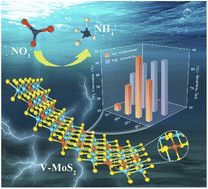Vanadium defect-engineering in molybdenum disulfide for electrochemical nitrate reduction†
Abstract
The electrochemical nitrate reduction reaction (NITRR) provides a promising option for nitrate pollutant removal and ammonia production under ambient conditions, which requires electrocatalysts with high activity. Here, bio-inspired metalloenzymes MoS2 nanoflowers with defect-engineering via vanadium doping (V–MoS2) prepared by a one-step hydrothermal method are verified to show remarkable NITRR capability. The introduction of highly conductive vanadium changes the electron orbitals and the metalloenzyme-like structure of the MoS2, making the 15% V–MoS2 catalyst exhibit a high-efficiency nitrate removal rate of 95% and excellent ammonia selectivity of 89.5% at −1.1 V versus the reversible hydrogen electrode (RHE) in 0.5 M Na2SO4 solution. Density functional theory (DFT) calculations reveal that the reduced energy barrier of 0.41 eV, correlated with hydrogenation of *NO to *NOH, plays a crucial part in the enhanced nitrate removal rate and NH4+ selectivity of V–MoS2. This work opens up a new avenue for the design of bio-inspired metalloenzyme catalysts for the NITRR.

- This article is part of the themed collections: Celebrating International Women’s Day: Women in Materials Science, 2022 Journal of Materials Chemistry A Most Popular Articles and 10th Anniversary: Most popular articles


 Please wait while we load your content...
Please wait while we load your content...